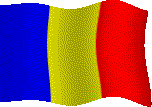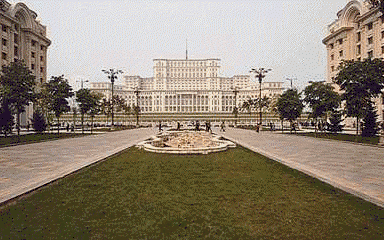



















 Casa Parlamentului
Casa Parlamentului
 Pictures from Romania
Pictures from Romania  Cusaturi Artizanale - Seams from Romania. - Motive culese de prin toata tara.
Cusaturi Artizanale - Seams from Romania. - Motive culese de prin toata tara.  Romania's Counties ( all 40 of them)
Romania's Counties ( all 40 of them)  Land and climate
Land and climate Plants and Animals
Plants and Animals People and Culture
People and Culture Romanian People and Population Facts
Romanian People and Population Facts Economy and Transportation
Economy and Transportation Government and History
Government and History A Much More Detailed History Of Romania - Istoria Romanilor In Detaliu -- (with historical pictures)
A Much More Detailed History Of Romania - Istoria Romanilor In Detaliu -- (with historical pictures)
 Facts about Romania
Facts about Romania
 Map of Romania
Map of Romania Coat of Arms
Coat of Arms Links to romanian sites - includes newspapers, media,TV and radio stations, official and unofficial sites on the Web.
Links to romanian sites - includes newspapers, media,TV and radio stations, official and unofficial sites on the Web. Millennium Chat
Millennium Chat Super chat
Super chat


The area of Romania is 91,699 square miles (237,500 square kilometers). It is bounded on the north and east by Ukraine and Moldova, on the northwest by Hungary, on the southwest by Yugoslavia, on the south by Bulgaria, and on the southeast by the Black Sea.
About 30 percent of the country is covered by mountains. The main ranges are the Eastern and Southern Carpathians. Some peaks in the Eastern Carpathians reach more than 7,500 feet (2,280 meters) in height, while the Southern Carpathians reach 8,346 feet (2,544 meters) at the peak of Moldoveanul, the highest point in Romania. In the west there is a smaller area of mountains known as the Western Carpathians. They reach more than 5,900 feet (1,800 meters) in height.
Bordering the Carpathian ranges are zones of hills and tablelands. To the east of the Eastern Carpathians there is the Moldovan Plateau, while to the west is the large Transylvanian Plateau. In the east the Dobrogea Plateau extends from the Danube River to the Black Sea. To the south of the zone of foothills and plateaus lies the great Walachian Plain. In the west of the country the smaller Tisza River plain extends from the Western Carpathians to the Hungarian border. Another area of flatland is the Danube River delta. The delta is in an area of swamps, sandbanks, and floating reed islands.
The longest river is the Danube, which flows for 668 miles (1,075 kilometers) through Romanian territory to the Black Sea. Most other rivers are tributaries of the Danube; the major ones are the Jiu, Olt, Arge, and Ialomia--all of which flow across the Walachian Plain. The Siret and the Prut flow from the northeast. The second longest river, the Mure, flows for 477 miles (768 kilometers) westward to join in Hungary the Tisza, a tributary of the Danube. There are no lakes of any large size.
The soils of Romania vary greatly. The most fertile are the black-earth soils of the plains, but much of the country is covered by brown forest soils of moderate fertility. The soils of the mountain and hill regions are less fertile.
Romania has a variety of mineral resources. The major sources of energy are natural gas and petroleum. Extraction of petroleum began as early as the 1850s, and reserves are now small. They are expected to be exhausted by the mid-1990s. Natural gas reserves are much larger. Coal supplies are limited and include hard coal and lignite.
Metallic minerals include copper, lead, zinc, bauxite, iron ore, chromium, manganese, and uranium. Gold, silver, and other rare metals are also found. Most of these deposits are sufficient for domestic requirements. The country does not have enough iron ore for its needs, however, and some must be imported.
Romania's climate is continental, with hot summers and cold winters. Winters in the mountains are particularly severe. Precipitation varies from region to region with highest levels in the mountains. On the whole the climate is good for farming. Bucharest, on the Walachian Plain, has an average July temperature of 74° F (23.3° C) and a January temperature of 27° F (-2.8° C). Annual precipitation averages 22.8 inches (58 centimeters).
About a quarter of the country's area is covered by forests, of which about 60 percent are in the mountains. Fir and spruce are the most common trees in the mountains, while the lower slopes have forests of deciduous trees such as beech and oak. The plains and tablelands have grass vegetation with scattered trees. The Danube Delta has vast areas of reeds and other aquatic plants.
Animal life includes such animals as the chamois, bear, lynx, deer, wolf, fox, badger, and polecat. A large variety of birds includes the eagle, vulture, and hawk. Pelicans are common in the Danube Delta. A large number of species of sea and freshwater fishes are also found.
The population of Romania is more than 23 million. Of these the majority (88 percent) are Romanians. There are about 1.8 million Hungarians (about 8 percent of the population), who live mainly in the center of the country. There are about 371,000 Germans. They are permitted to immigrate to Germany, but Hungarians may not move to Hungary. There are about 255,000 Gypsies and about 26,000 Jews. Emigration of Jews is permitted.
The Romanian language is a Romance language akin to Italian and Spanish but containing some Slavic words. The Romanians are proud of their Latin heritage, which distinguishes them from their Slav and Hungarian neighbors.
The Romanians belong mainly to the Romanian Orthodox church, which receives considerable government recognition and support. Most other Romanians are Greek Orthodox or Muslim. There are some Protestants.
About 53 percent of the population live in cities. The largest city is the capital, Bucharest (Bucuresti), with more than 2.3 million inhabitants, or about 19 percent of the urban population of the country (see Bucharest). Other large cities are Brasov, Timisoara, Iasi, Cluj-Napoca, Constanta, Galati, Craiova, Ploiesti, and Braila.
Education is free and compulsory from ages 6 to 16. There are six universities--in Bucharest, Iasi, Cluj-Napoca, Timisoara, Craiova, and Brasov. There are also several institutes and colleges of higher education.
Romania has a rich and varied folk culture. Folk music is popular, as is folk poetry. Each of the country's regions has its own costumes, art, and customs.
From this folk culture modern Romanian artists, musicians, and writers have gained much of their inspiration. Romanian poets such as Mihai Eminescu, writers such as Mihail Sadoveanu, and musicians such as George Enescu--have drawn on the rich heritage of Romanian folk life. Artists, such as the sculptor Constantin Brancusi and the painter Nicolae Grigorescu, were influenced by French ideas (see Brancusi, Constantin).
Agriculture still plays a large role in the Romanian economy, with about 20 percent of the population engaged in farming. Agriculture was collectivized by the government in 1949, but a land reform program begun in 1991 returned more than 80 percent of the country's agricultural land to nearly 5.5 million small farmers. Corn (maize) is the major crop, followed by wheat, potatoes, sugar beets, grapes, and cabbages. Romania is noted for its orchards and vineyards, and a variety of wines are produced and exported. Sheep and pigs are kept in large numbers, along with cattle.
Industry in Romania was state-owned until the fall of Romania's Communist government in 1989. Privatization of state-owned businesses began in 1991. The iron and steel industry, engineering, and petrochemicals are the country's leading industries. A large investment in petrochemical plants coincided with a decrease in Romania's reserves and the need to import oil.
The manufacturing industry produces tractors, motor vehicles, ships, machine tools, and other equipment. The textile industry is significant and produces clothing for export. The forestry industry supplies material to be used in the manufacture of furniture and pulp and paper.
Compared with other European countries, the production of electric power lags despite the construction of the largest hydroelectric power station in Europe. It is located on the Danube River.
The railroad is the major form of transportation but has a relatively sparse network. The road network is larger, but there are few major highways. The Danube River, the main water route, is connected with the Black Sea by a new canal to the port of Constanta. The national airline is Tarom, which operates from the Bucharest airport. Radio and television broadcasting was controlled by the state, as was telephone and telegraph service until 1990, when the state broadcasting service was renamed Romanian Free Television with major programming changes. A new independent press agency and a variety of newspapers flourished.
Once part of the Roman Empire, as its name and language indicate, Romania has had a long and varied history. At various times its territory has been occupied by Hungarians, Turks, and Russians, but after World War I Romania emerged as a united country. A member of the Soviet bloc for more than 40 years, Romania was the last unreconstructed stronghold of old-line Stalinist Communism to fall as democratic reforms swept the rest of Eastern Europe in late 1989.
For more than 40 years Romania was a socialist republic controlled by the Romanian Communist party, led by the general secretary, Nicolae Ceausescu. His regime was overthrown in December 1989. On Jan. 12, 1990, the Communist party was outlawed, and a popular front introduced measures to lead the country to a free-market economy.When the Romans, under the command of the emperor Trajan, invaded and occupied the territory of present-day Romania in AD 101, they found it populated by the Dacians. Latin-speaking colonists from other parts of the empire arrived, and eventually a mixed Dacian-Roman population developed. They were ancestors of the modern Romanians.
Little is known of Romania until about the 10th century. At that time Hungarians arrived from the east and settled in the province known as Transylvania. For centuries thereafter Transylvania was a disputed territory with both Romanians and Hungarians claiming possession.
Transylvania became part of the Hungarian state, and Romanian states were established in Walachia, south of the Carpathians, and in Moldavia to the east. These states suffered during the Turkish invasion and occupation of southeastern Europe in the 14th and 15th centuries. One of the Turkish-appointed rulers of Walachia, Michael the Brave (Mihai Viteazul), revolted against the Turks and defeated them in 1595. He crossed into Transylvania and defeated a Hungarian army. In 1600 he declared himself ruler of Walachia, Moldavia, and Transylvania and was thus the first ruler of a united Romania. The following year he was murdered, and the Turks resumed control.
After the Russo-Turkish War of 1828-29, the Russians became a major power in the region. Although the Turks still controlled most of the Romanian lands, their power had weakened. In 1859 Walachia and Moldavia were united under the name Romania. In 1877 Turkish control of Romania ended, but Russia retained Bessarabia. International recognition came after the signing in 1878 of the Treaty of Berlin. Transylvania remained under Hungarian control. In 1881 Charles I became the first king of Romania.
World War I and the defeat of Austria-Hungary by the Allies gave Romania the opportunity to occupy Transylvania in 1918. At the same time Bessarabia (Basarabia) was reunited with Romania. The 1920s and 1930s were marked by considerable political unrest. King Carol II, who came to the throne in 1930, yielded to Soviet pressure in 1940 to surrender Bessarabia and to German pressure to yield part of Transylvania to Hungary. Carol fled the country, and his son Michael was declared king. The country was run, however, by Gen. Ion Antonescu, who had German support.
Antonescu took part in the 1941 German invasion of the Soviet Union, regaining Bessarabia. This participation, however, was disastrous for the Romanians, who lost some 350,000 men in the fighting. When the Soviet army entered Romania in 1944, King Michael arrested Antonescu and pledged support for the Soviet Union against Germany.
At the end of World War II the Soviets gave Transylvania back to Romania as a reward for participation on their side but kept Bessarabia. In 1947 the Communists seized power with Soviet support, and King Michael abdicated. Local Communists proclaimed the Romanian People's Republic in 1948.
Romania began to develop its own foreign policy while maintaining a rigid Communist system at home. This policy was continued by Nicolae Ceausescu, who became party leader in 1965 and ruled with a fist of iron for the next 24 years. As other Communist governments began to fall in late 1989, he vowed never to relinquish power. His regime collapsed after he ordered troops to fire on a crowd of protesters. Thousands of antigovernment protesters were killed by the security forces. Ceausescu and his wife fled but were captured by the armed forces, summarily tried, and executed by firing squad on Dec. 25, 1989.
From the December revolution to Feb. 1, 1990, the country was ruled by the 145-member National Salvation Front. A coalition of parties replaced the Front until May 20, when Romania held its first free national elections in 53 years. The presidential candidate of the Front, former Communist Ion Iliescu, easily won. The lack of a strong opposition worried Romanians who saw in later government crackdowns on anti-Communist protesters evidence that the new government might be little different from the old Communist regime. Western industrialized nations agreed in 1991 to allow Romania into an economic aid program set up to help the emerging democracies in Eastern Europe. Iliescu won reelection to the presidency in 1992, and he named Nicolae Vacaroiu prime minister. In 1994 Romania agreed to acclerate its economic reforms, including a large-scale privatization program, in exchange for a $700 million loan from the International Monetary Fund. Romania was the first of 22 countries to join the North Atlantic Treaty Organization (NATO) Partnership for Peace program in 1994.
Official Name. Romania. Capital. Bucharest. Area. 91,699 square miles (237,500 square kilometers). Population (1995 estimate). 22,693,000; 247.5 persons per square mile (95.5 persons per square kilometer); 54.6 percent urban, 45.4 percent rural. Major Language. Romanian (official). Major Religion. Romanian Orthodox. Literacy. 96.7 percent. Highest Peak. Moldoveanul. Major Rivers. Danube, Mures, Jiu, Olt, Arges, Ialomita. Form of Government. Republic. Chief of State. President. Head of Government. Prime Minister. Legislature. Senate (143 members) and House of Deputies (341 members); both elected for four-year terms. Voting Qualification. Age 18. Political Divisions. 40 counties and one municipality. Major Cities (1993 estimate). Bucharest (2,066,723), Iasi (337,643), Timisoara (325,359), Brasov (324,104), Cluj-Napoca (321,850). Chief Manufactured and Mined Products. Tractors, motor vehicles, ships, machine tools, clothing, furniture, pulp, paper, chemicals, natural gas, coal, copper, lead, zinc, bauxite, iron ore, chromium, manganese, uranium, gold, silver, fuels. Chief Agricultural Products. Crops--corn (maize), wheat, rye, potatoes, sugar beets. Livestock and fish--sheep, pigs, cattle, freshwater fish and seafood. Monetary Unit. 1 Romanian leu = 100 bani.
 since September 27, 1998.
since September 27, 1998.


